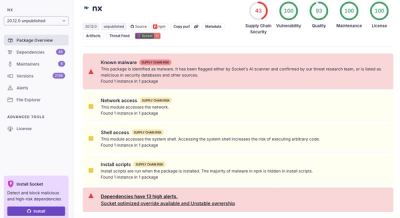
Security News
/Research
Wallet-Draining npm Package Impersonates Nodemailer to Hijack Crypto Transactions
Malicious npm package impersonates Nodemailer and drains wallets by hijacking crypto transactions across multiple blockchains.
In your AndroidManifest.xml
.....
<permission
android:name="${applicationId}.permission.C2D_MESSAGE"
android:protectionLevel="signature" />
<uses-permission android:name="${applicationId}.permission.C2D_MESSAGE" />
<uses-permission android:name="android.permission.WAKE_LOCK" />
<uses-permission android:name="android.permission.VIBRATE" />
<application ....>
<receiver
android:name="com.google.android.gms.gcm.GcmReceiver"
android:exported="true"
android:permission="com.google.android.c2dm.permission.SEND" >
<intent-filter>
<action android:name="com.google.android.c2dm.intent.RECEIVE" />
<category android:name="${applicationId}" />
</intent-filter>
</receiver>
<service android:name="com.dieam.reactnativepushnotification.modules.RNPushNotificationRegistrationService"/>
<service
android:name="com.dieam.reactnativepushnotification.modules.RNPushNotificationListenerService"
android:exported="false" >
<intent-filter>
<action android:name="com.google.android.c2dm.intent.RECEIVE" />
</intent-filter>
</service>
.....
In android/settings.gradle
...
include ':react-native-push-notification'
project(':react-native-push-notification').projectDir = file('../node_modules/react-native-push-notification/RNPushNotificationAndroid')
In android/app/build.gradle
...
dependencies {
...
compile project(':react-native-push-notification')
}
Register module (in MainActivity.java)
import android.content.Intent; // <--- Import Intent
import com.dieam.reactnativepushnotification.ReactNativePushNotificationPackage; // <--- Import Package
public class MainActivity extends Activity implements DefaultHardwareBackBtnHandler {
private ReactNativePushNotificationPackage mReactNativePushNotificationPackage; // <------ Add Package Variable
/**
* Returns the name of the main component registered from JavaScript.
* This is used to schedule rendering of the component.
*/
@Override
protected String getMainComponentName() {
return "YOUR_APP_NAME";
}
/**
* Returns whether dev mode should be enabled.
* This enables e.g. the dev menu.
*/
@Override
protected boolean getUseDeveloperSupport() {
return BuildConfig.DEBUG;
}
/**
* A list of packages used by the app. If the app uses additional views
* or modules besides the default ones, add more packages here.
*/
@Override
protected List<ReactPackage> getPackages() {
mReactNativePushNotificationPackage = new ReactNativePushNotificationPackage(this); // <------ Initialize the Package
return Arrays.<ReactPackage>asList(
new MainReactPackage(),
new VectorIconsPackage(),
new FabricPackage(),
mReactNativePushNotificationPackage // <---- Add the Package
);
}
// Add onNewIntent
@Override
protected void onNewIntent (Intent intent) {
super.onNewIntent(intent);
mReactNativePushNotificationPackage.newIntent(intent);
}
....
}
var PushNotification = require('react-native-push-notification');
PushNotification.configure({
// (optional) Called when Token is generated (iOS and Android)
onRegister: function(token) {
console.log( 'TOKEN:', token );
},
// (required) Called when a remote or local notification is opened or received
onNotification: function(notification) {
console.log( 'NOTIFICATION:', notification );
},
// ANDROID ONLY: (optional) GCM Sender ID.
senderID: "YOUR GCM SENDER ID",
// IOS ONLY (optional): default: all - Permissions to register.
permissions: {
alert: true,
badge: true,
sound: true
},
// Should the initial notification be popped automatically
// default: true
popInitialNotification: true,
/**
* IOS ONLY: (optional) default: true
* - Specified if permissions will requested or not,
* - if not, you must call PushNotificationsHandler.requestPermissions() later
*/
requestPermissions: true,
});
When any notification is opened or received the callback onNotification is called passing an object with the notification data.
Notification object example:
{
foreground: false, // BOOLEAN: If the notification was received in foreground or not
message: 'My Notification Message', // STRING: The notification message
data: {}, // OBJECT: The push data
}
PushNotification.localNotification(details: Object)
PushNotification.localNotificationSchedule(details: Object) (IOS ONLY)
EXAMPLE:
PushNotification.localNotification({
/* Android Only Properties */
id: 0, // (optional) default: Autogenerated Unique ID
title: "My Notification Title", // (optional)
ticker: "My Notification Ticker", // (optional)
largeIcon: "ic_launcher", // (optional) default: "ic_launcher"
smallIcon: "ic_notification", // (optional) default: "ic_notification" with fallback for "ic_launcher"
/* iOS and Android properties */
message: "My Notification Message" // (required)
});
// IOS ONLY
PushNotification.localNotificationSchedule({
message: "My Notification Message", // (required)
date: new Date()
});
Same parameters as PushNotification.localNotification()
PushNotification.checkPermissions(callback: Function) Check permissions
PushNotification.setApplicationIconBadgeNumber(number: number) set badge number
PushNotification.getApplicationIconBadgeNumber(callback: Function) get badge number
PushNotification.abandonPermissions() Abandon permissions
PushNotification.localNotificationSchedule() Android supportFAQs
In your `AndroidManifest.xml` ```xml .....
We found that edi-push demonstrated a not healthy version release cadence and project activity because the last version was released a year ago. It has 1 open source maintainer collaborating on the project.
Did you know?

Socket for GitHub automatically highlights issues in each pull request and monitors the health of all your open source dependencies. Discover the contents of your packages and block harmful activity before you install or update your dependencies.

Security News
/Research
Malicious npm package impersonates Nodemailer and drains wallets by hijacking crypto transactions across multiple blockchains.

Security News
This episode explores the hard problem of reachability analysis, from static analysis limits to handling dynamic languages and massive dependency trees.

Security News
/Research
Malicious Nx npm versions stole secrets and wallet info using AI CLI tools; Socket’s AI scanner detected the supply chain attack and flagged the malware.